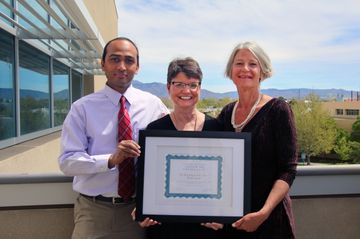
Recognized as Center of Excellence on 4/8/2017, Public Announcement
Phone: (505) 272-3160
Address: 915 Camino de Salud, Albuquerque, NM 87131
Number of CCM research publications 2011-2016: 10+
Faculty
Medical Director and Vascular Neurologist: Dr. Michel Torbey
Cerebrovascular Neurosurgeons: Dr. Andrew Carlson, Dr. Anish Deshmukh and Sean Deloach, NP
Vascular Neurologists: Dr. Tarun Girotra, Dr. Monika Manchanda, Dr. Maryam Hosseini
Epileptologist: Dr. Jose Padin-Rosado, Dr. Ken Imerman, Dr. Anna Bhat
Geneticist: Dr. Randall Heidenreich
Pediatric Neurology: Dr. Kathy Wolfe
Genetic Counselor: Joanne Drautz-Milisa, CGC
Neuroradiology: Dr. Mark Mabray
Nurse Coordinator: Dawn Aldridge, RN
Nurse Educator – Michael Richardson, RN
Educator Coordinator – Brittany Gagne
Research Program Patient Enrollment: 505-272-3194
Summary of the University of New Mexico Research Program
A primary focus of CCM research at our institution is to identify biological markers or modifiers of the disease and to monitor the progression and severity of CCM in our patients over time. We aim to collect natural history information (such as presentation of CCM, symptoms, extent of neurological disability, quality of life measures) and tie these to a patient’s radiological data (number, size and location of cavernous malformations with note of any evidence of hemorrhage) and blood sample (which is examined for specific cellular components that may be indicative of the disease severity). With this research, we wish to identify the cellular players that can cause such wide variability of symptoms and radiological findings, even within a single family. Additionally, there is research being done at UNM that is targeted at incidental findings correlated with the disease that are outside of the central nervous system – such as the prevalence of vertebral hemangiomas in the spine. There is preliminary research that has sparked our fascination with the gut, as the microbiome may actually be an explanatory piece of the CCM mystery, rather than an incidental finding; we are just beginning our investigations in this area. We are also interested in the behavioral and emotional elements of CCM, like the psychological and social barriers to genetic testing and the patient perspective of the diagnostic process.
This research is relevant to patients for several reasons. First, it allows them more information as to how the disease changes over time; in this way, they can become more knowledgeable as to the possibility for growth or multiplication of lesions as well as the potential for hemorrhage or new symptoms to occur. Our research aims to identify molecular components that may be responsible for the variability of the disease. CCM patients regularly ask why it is that their siblings or relatives are so severely affected by the illness while they themselves remain asymptomatic; in studying cellular modifiers and their association with a wide range of symptoms over a large cohort of patients, we hope to be able to answer these types of questions. Together with our partners at UCSF, our genome-wide association (GWAS) studies are significant for patients because the better comprehension we have of the molecular genetics, the better the opportunities for readiness and participation in clinical trials – trials that may provide treatment in the future. In terms of identifying biomarkers, this research is important for patients because it can aid physicians in delivering a proper diagnosis. For example, if a radiologist were to note adrenal calcifications on the CT of a patient’s abdomen or if a dermatologist were to examine a vascular malformation on a patient’s skin, it may alert the physician of a potential marker for CCM diagnosis, allowing the patient to more promptly receive a brain MRI and subsequent necessary care. Radiological studies like our spinal cord malformations and vertebral hemangiomas research can expand patient and physician knowledge of the disease, so as to better understand the disease involvement beyond the brain. This type of research can make patients more cognizant as to symptoms and findings of which they may not initially be aware when given a CCM diagnosis. Several areas of research at UNM that are more focused on the psychosocial and behavioral aspects of the disease are relevant to patients because of the emotional burden that is often closely linked to the CCM diagnosis. As we move forward with these studies, physicians will have a better understanding of the effects of CCM on a patient’s behavior, mood and social life, which are very important factors to consider in evaluating a familial disease.
Patient Education Activities at the University of New Mexico
Family CCM conferences have been held almost annually since 2008. These seminars provide updates to patients and family members for clinical care and research and are provided by both UNM and visiting faculty. They are complemented by research opportunities in the afternoons, including annual clinical research follow-up visits and longitudinal project imaging and follow up sessions. In addition, under a Brain and Behavior Health Institute PCORI grant initiatives, thirty patients and ten clinical/research team members (including the founding president of the national Alliance to Cure Cavernous Malformation, Dr. Connie Lee), had a 3-day training session with the national Alan Alda Center for Communicating Science. This was followed by monthly meetings of the CCM Patient Partner Advisory group to form the basis of a PCORI grant letter of intent.
Updated 2.06.2023


